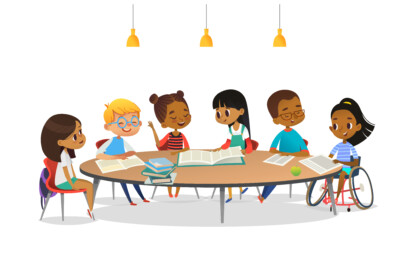Starting next week…
See what Dr. Stephen Krashen shared with me during our recent chat. You’ll learn who he credits for the affective filter hypothesis he’s written so much about, as well as how he was inspired by the Grateful Dead. Don’t miss it!
Dear Dr. Mooney…
This is my first year teaching third grade, and I’m trying to figure out how I should group my students for reading. Some of my colleagues have three reading groups they meet with each week. Essentially, the students are divided into below-, at-, and above-grade level groups.
I’ve tried this with my class, too, but it is not as easy as it looks. Students in each group are not on the same level with different skills, so I find myself doing mini-lessons within these small group meetings. Perhaps only 2-3 students need the mini-lesson skill, and the other four sit there bored or finding ways to entertain themselves (Which is not always a good thing!).
I’m not sure where my English learners should fit into these groups either. Should I have a separate group for them? What about my students who have almost no English proficiency?
Do you have suggestions for the best way to organize my students for reading instruction? I feel like it’s really a hot mess right now!
Signed,
Messy Seeking Help
Dear Messy,
You’re not alone in your concerns. These types of questions have been around for a long time. I remember there being three reading groups when I was in elementary school. Sometimes the teachers tried to disguise the purpose of the groups by calling them the Redbirds, Bluebirds, and Blackbirds. (Did they think we couldn’t figure that out?)
Teachers today may be a little more subtle by using names of musical groups or sports teams to identify groups, but it still doesn’t take long for students to see through that. They know who the good readers are in the class, and who is struggling.
This doesn’t mean you can’t have groups in your class, but why can’t we just say, “Okay, it’s time for me to meet with Bobby’s Group. If you’re in the group with Bobby, bring your notebook to the table now.” Again, students already know what leveled group they’re in so there’s no need to call it the Low Group, or put a fancy name on it.
Aside from NOT giving names to reading groups, there are two key things you can do to meet your students’ needs.
Limit Grouping for Skill Instruction
I know it has become a “best practice” in many schools, but…
Do we ALWAYS need to group students for reading instruction?
When I taught third grade, I only had homogenous groups every other month. During those months, I divided students into 3-4 groups based upon classroom assessments and used guided reading strategies for non-fiction texts. Because I had leveled the students, I could choose texts that were appropriate for them and target skills that the majority of the group needed. (This might be similar to what you and your colleagues are already doing.)
If there were a few students like yours that needed a separate mini-lesson, then the next time I met with them separately. There is no need to make other students sit through a mini-lesson about a skill they have already mastered. ELs were mixed with native English speakers in all the groups, because we focused on skill development. Sure, more ELs would often be in the lower groups, but that’s not the reason they were in a particular group.
BTW, I referred to them as Bobby’s Group, Rachel’s Group, etc. The grouping arrangements changed each month because I would reassess students and base their placement on the skills being taught that month. This might be something new to try. Are your students always in the same skill groups? Could you find ways to rearrange them? This movement helps alleviate the stigma of a student being in “that” group.
Group by Reading Interest
During the opposite months when I wasn’t focused on skill work in non-fiction texts, students completed book clubs where they were in heterogeneous groups. I made sure to offer a range of book options that included different genres and reading levels. After listening to book talks on each text, students gave me their top three choices, and I made the ultimate decision of which group they would be in. That was primarily because there couldn’t be 15 kids in one group and only two in another!
I remember one third-grader who was an English learner with additional special education needs. She desperately wanted to be in a book club with her friends who had all chosen a book that was above her reading level. I hesitated, but decided to give her a try in the group. Her motivation to read the text was obvious! Even though it was clear she had not read or comprehended all of the assigned chapters, she came to the book club meetings and participated eagerly. Her comprehension of the text grew as she listened to her peers talk about it. Without knowing it, other students were scaffolding the text for her. This made her even more motivated to read the next part of the book. Because her peers helped her understand what was going on, she wanted to contribute more to the discussion next time.
This was just one benefit of heterogeneous groups. Additionally, students learned to appreciate others’ interpretation of the text, even if it was someone they had previously perceived as a “poor” reader. Various skills for decoding and comprehension could be woven through these discussions, and students learned the value of loving a good book. The focus of these groupings was on appreciating the text together, not on who was excelling and who was struggling with reading skills.
These are just a couple of ideas to try, Messy. I would encourage you to figure out a structure that works for you and your students, regardless of what your colleagues are doing.
Good luck!
Dr. Mooney
Those are my two-cents for Messy Seeking Help, but I wonder what you have to share. What have been your struggles or successes with grouping students for reading instruction?







